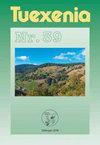德国东北部Schorfheide-Chorin生物圈保护区干草地复合体20年间植被变化不大。
IF 1.1
4区 生物学
Q3 PLANT SCIENCES
引用次数: 12
摘要
在中欧许多地区,由于土地利用变化、大气氮输入和气候变化,半自然草地经历了严重的植被变化,例如组成变化和总体物种损失。在这里,我们分析了德国最干旱地区之一的schorfhede - chorin生物圈保护区(勃兰登堡东北部)的干旱草地复群(Gabower Hänge)的植被变化。我们对4个典型群落(festion valesiacae, Koelerion glaucae, Armerion elongatae, Arrhenatherion elatioris)的4个10 m2的样地进行了重新采样,恢复精度约为20年。10 m。两次取样均记录了维管植物、苔藓植物和地衣的覆盖情况。用非趋势对应分析(DCA)分析了总体成分变化。为了解释这一变化,我们计算了新旧地块的未加权平均值Ellenberg指标值。此外,我们还分析了新旧样地间的物种多样性差异,以及物种丰富度、草本和隐苔层盖度、生态指标值、类群(维管植物、苔藓植物、地衣)未加权比例、区系状态(本地或非本地)、生命形式、csr策略类型和红色名录物种的差异。排序结果表明,植被变化不明显,但有向富营养化方向发展的趋势。养分和土壤反应的Ellenberg指标值与纵轴呈极显著相关。新样地特有物种28种,旧样地缺失45种。虽然没有物种显著减少,但有7种物种显著增加。新样地的平均物种丰富度显著增加。平均Ellenberg指标值无显著差异。维管植物、新生植物、半隐植物和cs -战略型植物的比例下降。总体植被变化较小,表明Gabower Hänge干草地复群仍处于良好状态,具有较高的保护价值。与整个温带欧洲许多其他干燥草原的情况相比,这种相对稳定的情况可能归因于低氮沉积和当地气候的干燥。但是,在今后的管理中应考虑到已发现的朝向更富营养条件的趋势。2016年4月14日收稿,2016年5月18日收稿本文章由计算机程序翻译,如有差异,请以英文原文为准。
Little vegetation change during two decades in a dry grassland complex in the Biosphere Reserve Schorfheide-Chorin (NE Germany).
In many regions of Central Europe, semi-natural grasslands have experienced severe vegetation changes, e.g. compositional change and overall species loss, because of land use changes, atmospheric nitrogen input and also climate change. Here we analysed the vegetation change in a dry grassland complex (Gabower Hänge) in the Biosphere Reserve Schorfheide-Chorin (NE Brandenburg, Germany), one of the driest regions of the country. We resampled four 10 m2 plots of each of four typical alliances (Festucion valesiacae, Koelerion glaucae, Armerion elongatae, Arrhenatherion elatioris) about 20 years after their original sampling with a recovery accuracy of approx. 10 m. The cover of vascular plants, bryophytes and lichens was recorded in both samplings. The overall compositional change was analysed with a detrended correpondence analysis (DCA). To interpret this change, we calculated unweighted mean Ellenberg indicator values for old and new plots. Furthermore we tested differences in constancy of individual species between old and new plots as well as differences in species richness, cover of herb and cryptogam layer, ecological indicator values and unweighted proportion of species groups (vascular plants, bryophytes, lichens), floristic status (native or not), life forms, CSR-strategy types and Red List species. The results of the ordination indicated no significant vegetation change, but revealed tendencies towards more nutrient-rich conditions. Ellenberg indicator values for nutrients and soil reaction were significantly correlated with the axes of the ordination. There were 28 species exclusively found in the new plots and 45 species of the old plots missing. While no species decreased significantly, there were seven species that increased significantly. Mean species richness was significantly increased in the new plots. There were no significant differences in mean Ellenberg indicator values. Proportions of vascular plants, neophytes, hemicryptophytes and CS-strategists decreased. We conclude that overall vegetation changes are small, indicating that the dry grassland complex at the Gabower Hänge is still in a good state and of high conservation value. This relative stability over time compared to the situation in many other dry grasslands throughout temperate Europe is likely attributable to low nitrogen deposition and the dryness of the local climate. However, the detected tendency towards more nutrient-rich conditions should be taken into account in future management. Manuscript received 14 April 2016, accepted 18 May 2016 Co-ordinating Editor: Balázs Deák 396
求助全文
通过发布文献求助,成功后即可免费获取论文全文。
去求助
来源期刊

Tuexenia
PLANT SCIENCES-
CiteScore
2.80
自引率
25.00%
发文量
0
期刊介绍:
Tuexenia publiziert Original- und Übersichtsarbeiten sowie Berichte zu Themen der Geobotanik / Vegetationsökologie und zu Nachbarwissenschaften wie Populationsökologie, Biodiversitätsforschung, Biozönologie, Renaturierungsökologie und ihren Anwendungen, vor allem im Naturschutz. Der geografische Schwerpunkt liegt in Zentraleuropa und angrenzenden Regionen.Tuexenia erscheint jährlich in einem Band, der etwa zur Jahresmitte fertig gestellt wird. Autoren erhalten von jeder Arbeit eine PDF-Datei und gemeinsam 20 Sonderdrucke kostenlos.
Die Qualität der wissenschaftlichen Manuskripte wird durch die Redaktion und einen Wissenschaftlichen Beirat (Peer Review) gesichert (s. auch die Manuskript-Richtlinien vor dieser Seite). Es werden keine Druckkosten erhoben. Tuexenia legt Wert auf allgemeine Online-Verfügbarkeit der Beiträge.
 求助内容:
求助内容: 应助结果提醒方式:
应助结果提醒方式:


